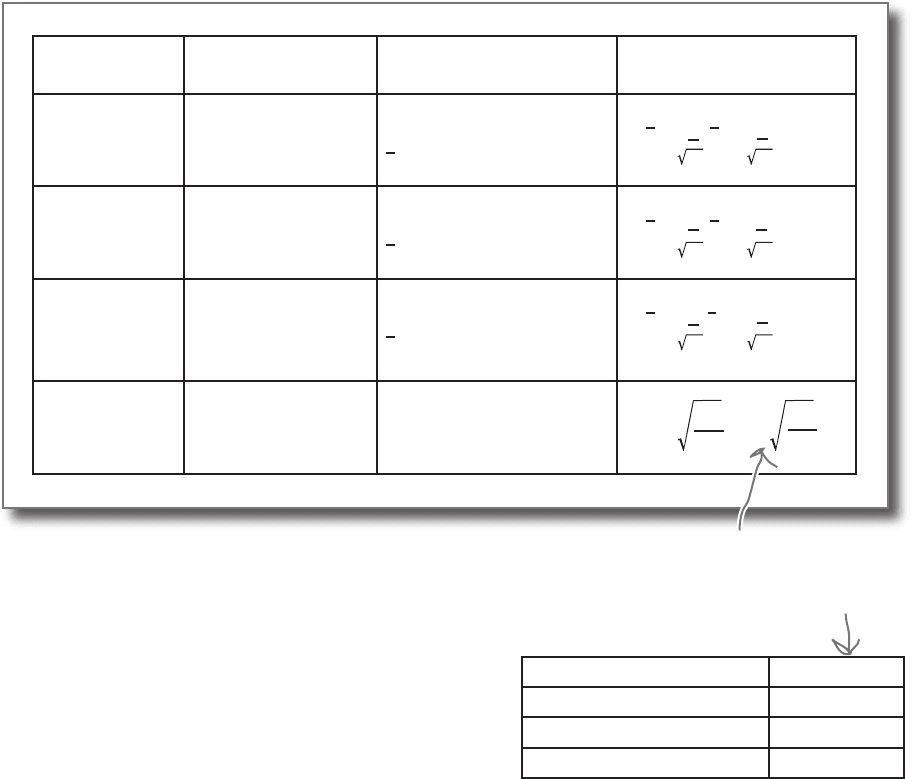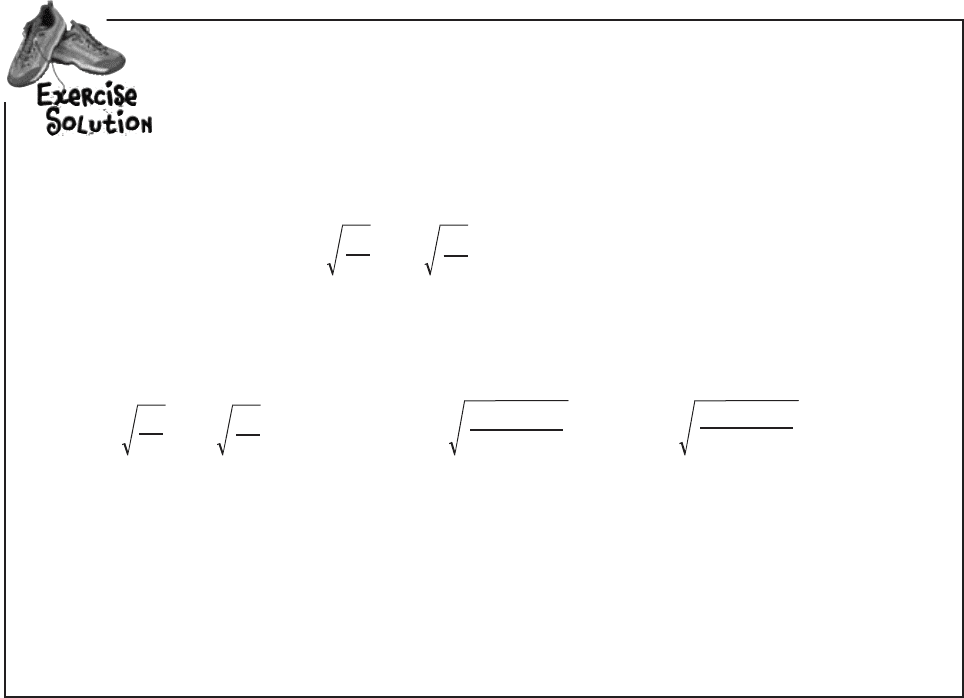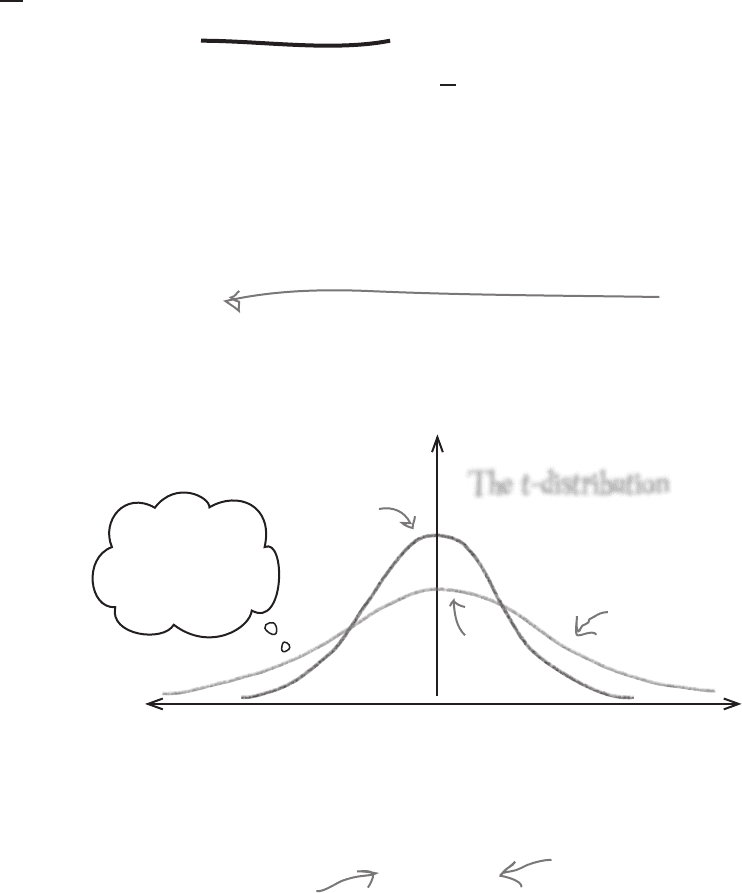Griffiths D. Head First Statistics
Подождите немного. Документ загружается.


you are here 4 501
constructing confidence intervals
Finally, find the value of X
Now that we’ve rewritten the inequality, we’re very close to finding a
confidence interval for μ that describes the amount of time gumball
flavor typically lasts for. In other words, we use
P(X - 0.98 < μ < X + 0.98) = 0.95
Here’s a quick sketch.
Our confidence limits are given by X – 0.98 and X + 0.98. If we knew
what to use as a value for X, we’d have values for the confidence limits.
I wonder if we can use the
Mighty Gumball sample in
some way. Maybe we can use
the mean of the sample.
X is the distribution of sample means, so we can
use the value of x from the Mighty Gumball sample.
The confidence limits are given by X – 0.98 and X + 0.98. For the
Mighty Gumball sample, x is given by 62.7. Use this to come up
with values for the confidence limits.
- 0.98
+ 0.98
0.025
0.025
0.95
X X

502 Chapter 12
You’ve found the confidence interval
Congratulations! You’ve found your first confidence interval. You
found that there’s a 95% chance that the interval
(61.72, 63.68) contains the population mean for flavor duration.
That’s fantastic news! That
means I can update the fine
print on our advertisements.
That should handle any lawsuits.
Using confidence intervals in the television advertisement rather
than point estimators means that the CEO can give an accurate and
precise estimate for how long flavor lasts, but without having to give
a precise figure. It makes allowances for any margin of error there
might be in the sample.
The confidence limits are given by X - 0.98 and X + 0.98. For the
Mighty Gumball sample, x is given by 62.7. Use this to come up
with values for the confidence limits.
The confidence limits are given by X - 0.98 and X + 0.98. If we substitute in the mean of the sample, we get
confidence limits of 62.7 - 0.98 and 62.7 + 0.98. In other words, our confidence interval is (61.72, 63.68).
sharpen solution

you are here 4 503
constructing confidence intervals
So does that mean I have to
go through the same process
every single time I want to
construct a confidence interval?
We can take some shortcuts.
Constructing confidence intervals can be a repetitive process, so there
are some shortcuts you can take. It all comes down to the level of
confidence you want and the distribution of the test statistic.
Let’s take a look at some of the shortcuts we can take.
Let’s summarize the steps
Let’s look back at the steps we went through in order to construct the
confidence interval.
The first thing we did was choose the population statistic that
we needed to construct a confidence interval for. We needed to find a
confidence interval for the mean duration of gumball flavor, and this
meant that we needed to construct a confidence interval for μ.
Once we’d figured out which population we needed to construct a
confidence interval for, we had to find its sampling distribution.
We found the expectation and variance of the sampling distribution of
means, substituting in values for every statistic except for μ. We then
figured out that we could use a normal distribution for X.
After that, we decided on the level of confidence we needed for the
confidence interval. We decided to use a confidence level of 95%.
Finally, we had to find the confidence limits for the confidence
interval. We used the level of confidence and sampling distribution to
come up with a suitable confidence interval.

504 Chapter 12
Handy shortcuts for confidence intervals
Here are some of the shortcuts you can take when you calculate confidence
intervals. All you need to do is look at the population statistic you want to
find, look at the distribution of the population and the conditions, and then
slot in the population statistic or its estimator. The value c depends on the
level of confidence
Population
statistic
Population
distribution
Conditions Confidence interval
μ Normal
You know what σ
2
is
n is large or small
x is the sample mean
(
x - c
σ
, x + c
σ
)
n n
μ Non-normal
You know what σ
2
is
n is large (at least 30)
x is the sample mean
(
x - c
σ
, x + c
σ
)
n n
μ Normal or non-normal
You don’t know what σ
2
is
n is large (at least 30)
x is the sample mean
s
2
is the sample variance
(
x - c
s
, x + c
s
)
n n
p Binomial n is large
p
s
is the sample proportion
q
s
is 1 - p
s
(
p
s
- c
p
s
q
s
, p
s
+ c
p
s
q
s
)
n n
Level of confidence Value of c
90% 1.64
95% 1.96
99% 2.58
The value of c depends on the level of
confidence you need. These values work
whenever you use the normal distribution
as the basis of your test statistic.
What’s the interval in general?
In general, the confidence interval is given by
statistic ± (margin of error)
The margin of error is given by the value of c multiplied
by the standard deviation of the test statistic.
margin of error = c
×
(standard deviation of statistic)
confidence interval cheat sheet

you are here 4 505
constructing confidence intervals
Mighty Gumball took a sample of 50 gumballs and found that in the sample, the proportion of red
gumballs is 0.25. Construct a 99% confidence interval for the proportion of red gumballs in the
population.

506 Chapter 12
Mighty Gumball took a sample of 50 gumballs and found that in the sample, the proportion of red
gumballs is 0.25. Construct a 99% confidence interval for the proportion of red gumballs in the
population.
p
s
- c
p
s
q
s
, p
s
+ c
p
s
q
s
n n
The confidence interval for the population proportion is given by
We need to find the 99% confidence interval so c = 2.58. The proportion of red gumballs is 0.25, so
p
s
= 0.25 and q
s
= 0.75. n = 50. This gives us
p
s
- c
p
s
q
s
, p
s
+ c
p
s
q
s
n n
=
0.25 - 2.58
0.25 x 0.75
, 0.25 + 2.58
0.25 x 0.75
50 50
= (0.25 - 2.58 x 0.0612, 0.25 + 2.58 x 0.0612)
= (0.25 - 0.158, 0.25 + 0.158)
= (0.092, 0.408)
exercise solution
(
( (
)
) )

you are here 4 507
constructing confidence intervals
Q:
When we found the expectation
and variance for X earlier, why did we
substitute in the point estimator for σ
2
and not μ?
A: We didn’t substitute x for μ because
we needed to find the confidence interval
for μ. We needed to find some sort of
expression involving μ that we could use to
find the confidence interval.
Q:
Why did we use x as the value of
X?
A: The distribution of X is the sampling
distribution of means. You form it by taking
every possible sample of size n from the
population, and then forming a distribution
out of all the sample means.
x is the particular value of the mean taken
from our sample, so we use it to help us find
the confidence interval.
Q:
What’s the difference between the
confidence interval and the confidence
level?
A: The confidence interval is the
probability that your statistic is contained
within the confidence interval. It’s normally
given as a percentage, for example, 95%.
The confidence interval gives the lower and
upper limit of the interval itself, the actual
range of numbers.
Q:
We’ve found that the 95%
confidence interval for μ is (61.72, 63.68).
What does that really mean?
A: What it means is that if you were to
take many samples of the same size and
construct confidence intervals for all of them,
then 95% of your confidence intervals would
contain the true population mean. You know
that 95% of the time, a confidence interval
constructed in this way will contain the
population mean.
Q:
In the shortcuts, do the values of c
apply to every confidence interval?
A: They apply to all of the shortcuts
we’ve shown you so far because all of
these shortcuts are based on the normal
distribution. This is because the sampling
distribution in all of these cases follows the
normal distribution.
Q:
I’ve sometimes seen “a” instead
of “c” in the shortcuts for the confidence
intervals. Is that wrong?
A: Not at all. The key thing is that whether
you refer to it as “a” or “c”, it represents
a value that you can substitute into your
confidence interval to give you the right
confidence level. The values stay the same
no matter what you call it.
Q:
So are all confidence intervals
based on the normal distribution?
A: No, they’re not. We’ll look at intervals
based on other distributions later on.
Q:
Why did we go through all those
steps when all we have to do is slot
values into the shortcuts?
A: We went through the steps so that you
could see what was going on underneath
and understand how confidence intervals
are constructed. Most of the time, you’ll just
have to substitute in values.
Q:
Do I need continuity corrections
when I’m working with confidence
intervals?
A: Theoretically, you do, but in practice,
they’re generally omitted. This means
that you can just substitute values into
the shortcuts to come up with confidence
intervals.
I have one more
problem I need your
help with. Think you can
help me out?

508 Chapter 12
Just one more problem...
Mighty Gumball has one last problem for you to sort out. One of the
candy stores selling gumballs wants to determine how much gumballs
typically weigh, as they find that their customers often buy gumballs
based on weight rather than quantity. If the store can figure out the
typical weight of a gumball, they can use this information to boost sales.
Mighty Gumball has taken a representative sample of 10
gumballs and weighed each one. In their sample, x = 0.5 oz and
s
2
= 0.09.
How do we find the confidence interval?
Assuming the weight of each gumball in the population follows a normal
distribution, how would you go about creating a 95% confidence interval for
this data? Hint: look at the table of confidence interval shortcuts and see which
situation we have here.
Step 1: Choose your population statistic
The first step is to pick the statistic we want to construct a confidence
interval for. We want to construct a confidence interval for the mean
weight of gumballs, so we need to construct a confidence interval for the
population mean, μ.
As we need to find the confidence interval for μ, this means that the next
step is to find its sampling distribution, the distribution of X.
That means I need you to come up with
a confidence interval for gumball weight,
but as it’s just for one store, I don’t want
to sample a large number of gumballs.
confidence interval dilemma: part deux

you are here 4 509
constructing confidence intervals
That’s easy. X is normal, so
that means that X has to follow
a normal distribution, too.
The normal distribution isn’t a good approximation
for every situation.
All of the sampling distributions we’ve seen so far either follow a
normal distribution or can be approximated by it. The trouble is that
we can’t use the normal distribution for every single confidence interval.
Unfortunately, this situation is one of them.
So why can’t we use the normal distribution here?
When sample sizes are large, the normal distribution is ideal for finding
confidence intervals. It gives accurate results, irrespective of how the
population itself is distributed.
Here we have a different situation. Even though X itself is distributed
normally, X isn’t.
So what’s the distribution of X?
There are two key reasons.
The first is that we don’t know what the true variance is of the
population, so this means we have to estimate σ
2
using the
sample data. We can easily do this using point estimators, but
there’s a problem: the size of the sample is so small that there are
likely to be significant errors in our estimate, much larger errors
than if we used a larger sample of gumballs. The potential errors
we’re dealing with mean that the normal distribution won’t give
us accurate enough probabilities for X, which means it won’t give
us an accurate confidence interval.
So what sort of distribution does X follow? It actually follows a
t-distribution. Let’s find out more.
But why not?
That doesn’t
make sense to me.
Step 2: Find its sampling distribution

510 Chapter 12
0
The t-distribution
The exact shape of the t-
distribution depends on the size
of the sample and the value of ν.
The two are related.
T ~ t(ν)
Small values of
ν always make
my tail look big.
The t-distribution is a probability distribution that specializes in exactly the
sort of situation we have here. It’s the distribution that X follows where the
population is normal, σ
2
is unknown, and you only have a small sample at
your disposal.
The t-distribution looks like a smooth, symmetrical curve, and it’s exact
shape depends on the size of the sample. When the sample size is large, it
looks like the normal distribution, but when the sample size is small, the
curve is flatter and has slightly fatter tails. It takes one parameter, ν, where
ν is equal to n – 1. n is the size of the sample, and ν is called the number
of degrees of freedom.
Let’s take a look at this. Here’s a sketch of the t-distribution for different
values of ν. Can you see how the value of ν affects the shape of the
distribution?
A shorthand way of saying that T follows the t-distribution with ν
degrees of freedom is
t(ν) means we’re using the t-distribution
with ν degrees of freedom. ν = n - 1.
The t-distribution works in a similar way to the normal distribution. We
start off by converting the limit of the probability area into a standard
score, and then we use probability tables to get the result we want.
Let’s start with the standard score.
large v
small v
T is the test statistic. You’ll see how
to calculate it on the next page
introducing t-distributions
X follows the t-distribution when the sample is small
We’ll look at degrees of
freedom in more depth
in Chapter 14.
